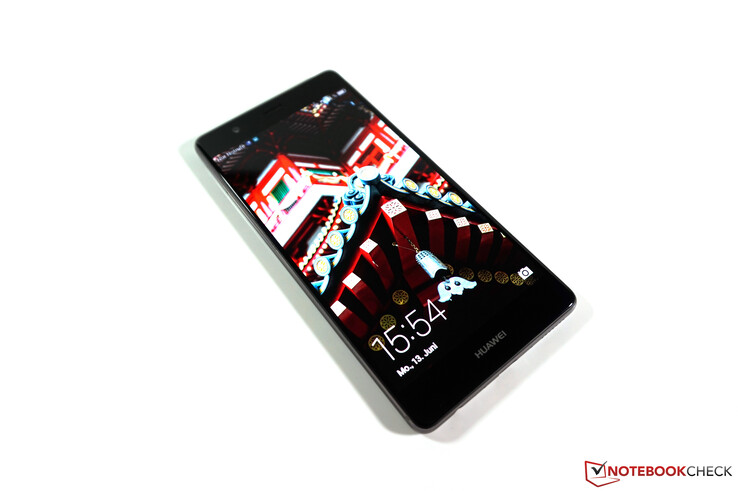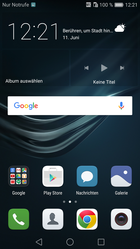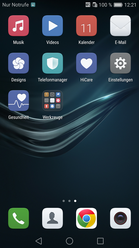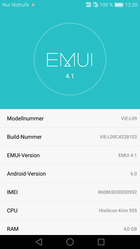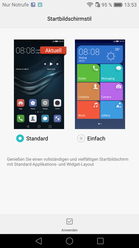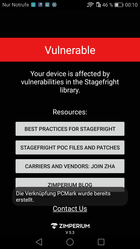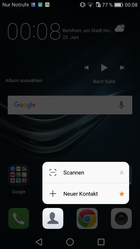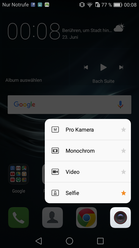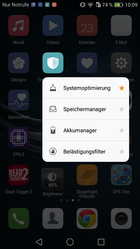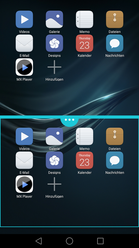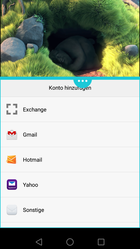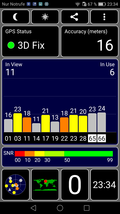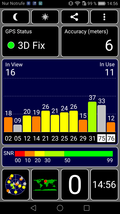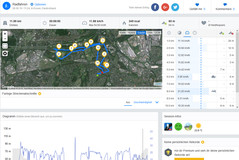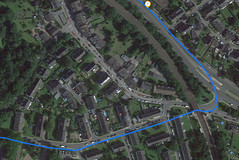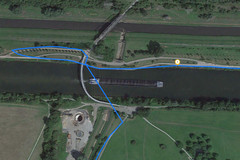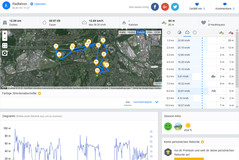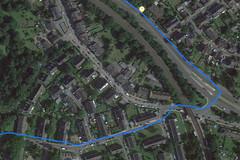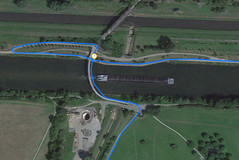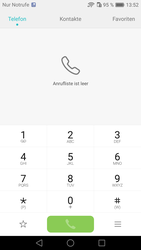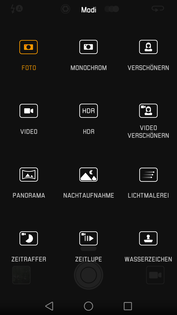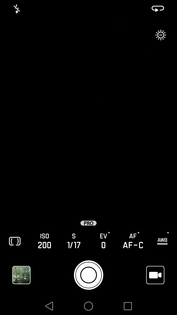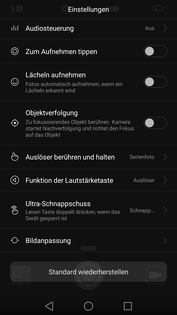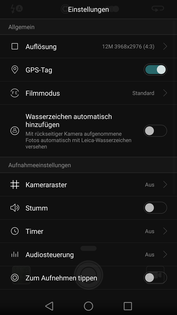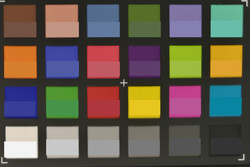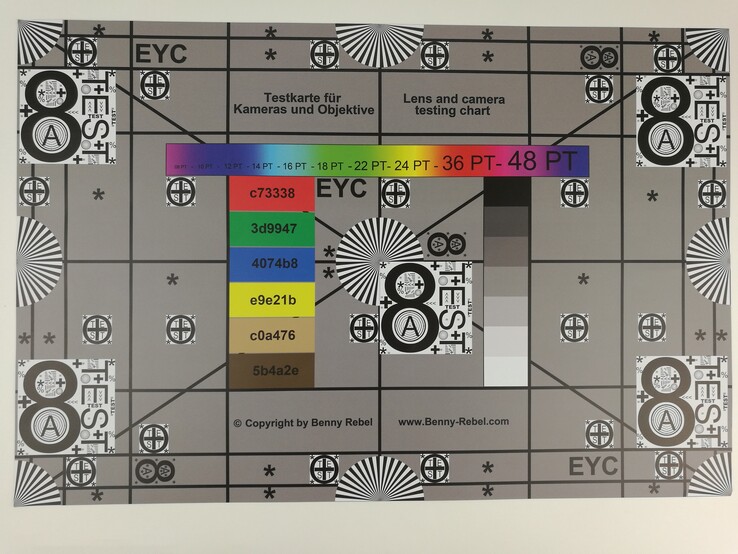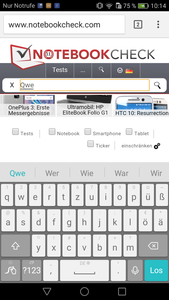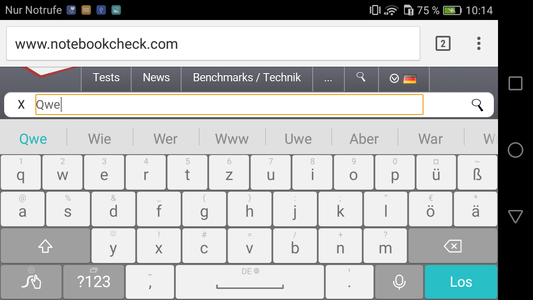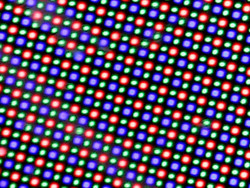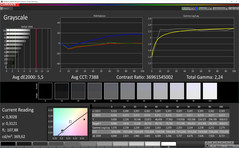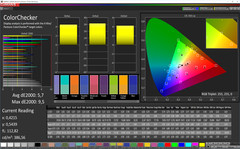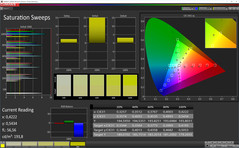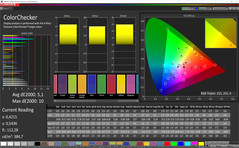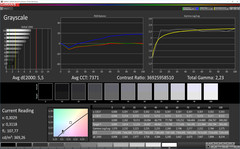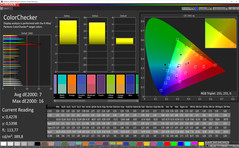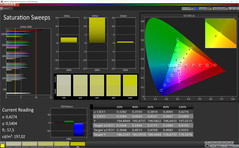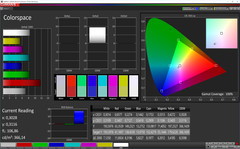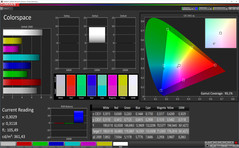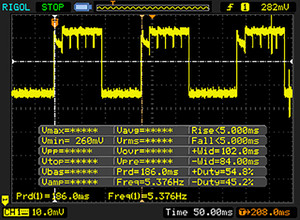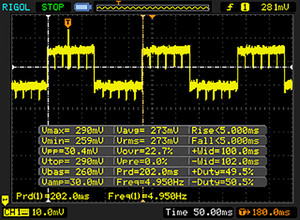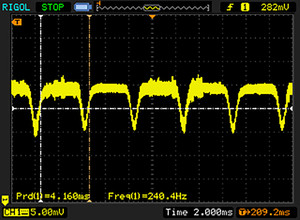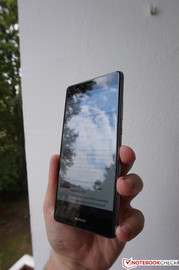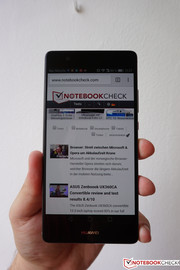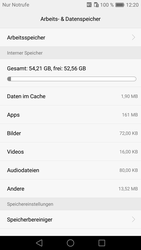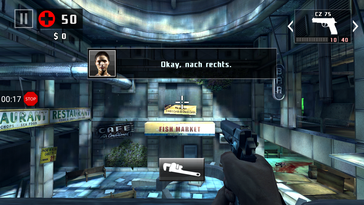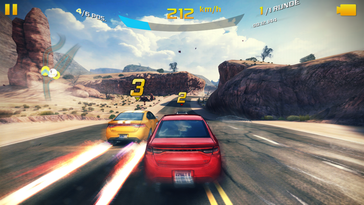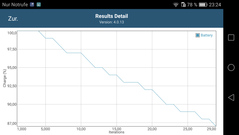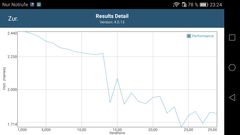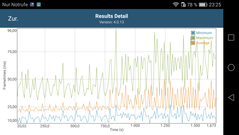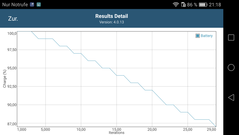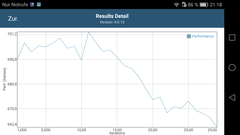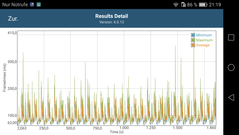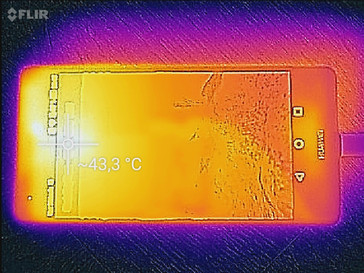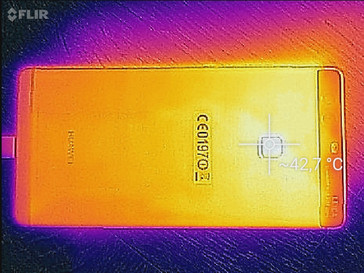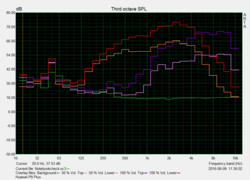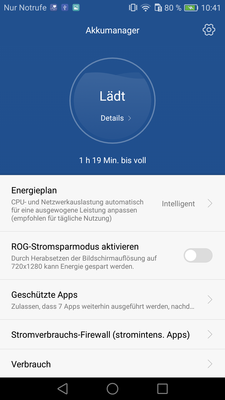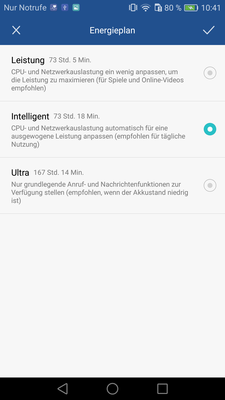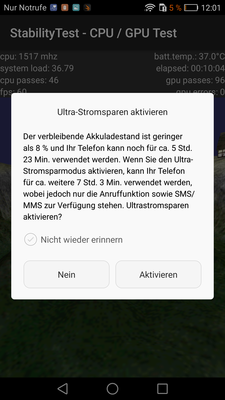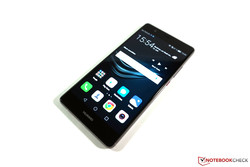Huawei P9 Plus Smartphone Review
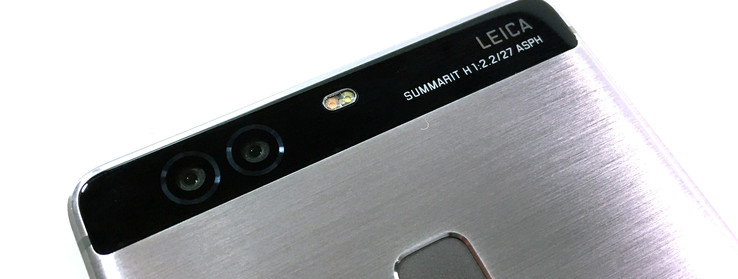
For the original German review, see here.
It is currently a trend to offer two versions of a smartphone. This is the case for high-end models, like from Apple (iPhone 6s/iPhone 6s Plus) or Samsung (Galaxy S7/Galaxy S7 Edge), and also for mainstream devices (Moto G4/Moto G4 Plus). Huawei follows this trend as well with its flagship device P9. We already reviewed the standard model and it managed a very good rating of 90%.
Manufacturers usually equip the more expensive versions with bigger screens, bigger batteries or also some additional features. All these three points are also true for the P9 Plus, but Huawei even goes a step further. The display is not only bigger (5.5 vs. 5.2-inch), but it is based on the AMOLED instead of IPS technology and supports pressure-sensitive inputs, which are called "Press Touch" by Huawei. Users also get a second speaker as well as an IR transmitter.
Huawei’s P9 Plus is definitely a premium product, which is supported by the pricing. At 699 Euros (~$773), the test model is 130 Euros (~$143) more expensive than the standard P9. There are numerous rivals in this segment, including the Samsung Galaxy S7 Edge, Apple iPhone 6s Plus, Microsoft Lumia 950 XL, Moto X Force, Sony Xperia Z5 Premium and the brand-new OnePlus 3 (review will follow soon).
Case
The cases from the two P9 models hardly differ from each other. Because of the bigger screen and the bigger battery (not replaceable), the P9 Plus is obviously a bit bigger and slightly heavier at 162 grams as well. You do not have to waive the excellent unibody chassis though. The rear cover has a slightly different texture (horizontal stripes) but is once again very smooth. Similar to the P9, we can measure a height of 7.1 mm, so the P9 Plus also misses the value in the spec sheet (6.95 mm).
The stability of the bigger model can completely convince us. Neither pressure nor twisting attempts are a problem for the smartphone and we cannot produce ripples on the screen, either. All gaps are even and the card tray (also aluminum) sits flush with the case. The premium case definitely meets the premium price. The P9 Plus is currently only available in gray (Quartz Gray) in Germany, but other regions also get models in white (Ceramic White) and gold (Haze Gold).
Connectivity
Huawei uses the fast Kirin 955 SoC with the Mali-T880 MP4 GPU for both P9 models, but there are differences in terms of memory and storage. While the standard P9 (not Premium) is only available with 32 GB storage and 3 GB RAM in Germany, the P9 Plus comes with 64 GB storage and 4 GB RAM. The internal storage can also be expanded by up to 128 GB via microSD-card. Apps cannot be transferred to the card via App2SD, but the card can be formatted as internal storage. The card will only work with this particular smartphone, but it is an inexpensive way to expand the storage capacity.
The other features of the P9 Plus cannot quite meet the expectations for the high price. We do get a modern USB-C port with OTG-support for the quick attachment of USB devices, but it only meets the USB 2.0 standard. We managed to transfer files to our PC (SSD) at around 50 MB/s and from the PC to the smartphone at around 33-38 MB/s.
Users of the P9 Plus also get an IR blaster at the top edge as well as the corresponding app called "Smart Controller". The app already includes many manufacturers and we could control the most important things of our Sony TV after a couple of minutes. Another highlight is the compatibility with DSLRs, where the P9 Plus can be used as a remote trigger. A step counter is also included and can be used in combination with the preloaded app "Health".
Connections to other devices are possible via Wi-Fi Direct, Miracast, NFC and Bluetooth 4.2, but you do not get an FM radio.
Software
Huawei ships the P9 Plus with the latest Android version 6.0 Marshmallow including its own user interface EMUI 4.1. The latter leaves a very clean impression and can be heavily customized. There is no app drawer and apps are just located on the home screens, where folders can help to organize them. Contrary to the smaller P9, our review unit of the P9 Plus was not filled with unnecessary gaming apps, but only some tools from the manufacturer.
Another little specialty is a small menu, which can be activated on the lock screen with a swipe from the bottom. Similar to Apple's iOS you will get access to some apps (voice recording, flashlight, calculator, camera) and you can skip through the preloaded wallpapers.
Besides regular screenshots, it is also possible to record screen videos. In addition to the actual screen content, you will also see your inputs visualized as circles. This is a good way to create How-To videos or capture gaming scenes, for example. The quality, however, is not very good, because the videos can only be captured in HD (1280x720 pixels, 21 fps, ~7 Mbps, 60 MB per minute) and Mini (768x432 pixels, 20 fps, ~1.3 Mbps, 10 MB per minute). The low fps number in particular is not representative for the actual user experience, which is extremely smooth and there are basically no stutters at all.
The Huawei P9 Plus also offers a split-screen mode (long press on the rectangle symbol), but the number of supported apps is very limited. The P9 Plus does offer another highlight, because the manufacturer implements a pressure-resistant touchscreen similar to the Mate S. Huawei calls this feature "Press Touch", and the functionality is already familiar from Apple's current iPhone generation. However, the feature is mainly limited to Huawei’s own apps. A hard press on the app will open a small context menu, and we included some examples below. This feature is really handy with pictures, where you can launch the zoom with pressure gestures.
Communication & GPS
Huawei only sells one global version of the P9 Plus, so the number of supported frequencies is pretty big (see specs at the beginning of this review for the full list) and you should be able to get a connection in many parts of the world. Similar to the standard P9, however, you can only get the single-SIM version (VIE-L09; dual-SIM: VIE-L29) here in Germany. The SoC supports fast LTE Cat. 6 (downstream up to 300 Mbps, upstream up to 50 Mbps), but not LTE Cat. 9. There is no criticism for the signal quality in the metropolitan T-Mobile network.
The supported WLAN standards also include the fast 802.11ac in 2.4 as well as 5 GHz networks. Huawei also advertises the so called WLAN + 2.0 feature, where the smartphone lists networks based on their signal quality and automatically switches to the best available network. This feature did work with our two test routers Fritz!Box 7490 and ASUS RT-AC56U. Depending on our position, the smartphone did not continue to use the weaker network, but automatically switched to the better one. Subjectively, the signal quality was excellent.
Inside the building, the Huawei P9 Plus can only locate the position when it is close to a window, but the accuracy is not very good in this case at 16 meters. The smartphone supports the satellite networks GPS, GLONASS and BeiDou. The initial location takes around 20 seconds outdoors with an accuracy down to 6 meters. We also check the performance on a bicycle ride and compare the results with the professional navigation device Garmin Edge 500. The overall distance on the smartphone is ~150 meters shorter, which is the result of some “shortcuts”. The position is not located as often in some areas, so the smartphone will draw a straight line. Still, there should not be any problems when you use it for navigation in the car or on a bike.
Telephone & Voice Quality
The bigger P9 model also leaves a very good impression when you make calls. Both people can hear clear voices without annoying background noises. The provided headset works well, but we actually preferred the hands-free function: We can hear the voice of the call partner loudly and clearly, and our voice is also recorded in a good quality.
We already know the Phone app from other Huawei smartphones and there should not be any problems with the handling. You can see the large numbers pad by default, but it is also possible to access the contacts and favorites.
Cameras
The camera equipment does not differ between the two Huawei P9 models, so we also want to refer to the review of the standard P9. At the front is an 8 MP camera, so Huawei follows the current selfie trend. The quality of the pictures is very good and is definitely sufficient for selfies. Thanks to the Beauty Mode, you can apply a soft focus, which will smoothen out folds or pronounce the eyes. This is certainly a nice gadget for some users. The camera still takes decent pictures in low-light situations.
We really like the camera app with its intuitive handling via swiping gestures. A swipe from the left opens the picture modes, a swipe from the right the settings. The professional mode can be accessed with a swipe from the bottom.
The most advertised feature of the P9 or P9 Plus, respectively, is definitely the dual-camera at the back, which was designed in cooperation with Leica according to Huawei. The maximum resolution is 13 MP (up to 3968x2976 pixels, 4:3) with one standard RGB sensor as well as a monochrome sensor. We can confirm the results from the Huawei P9 review. The test images are conveniently sharp and offer very rich colors in daylight in particular, which results in a very vivid picture impression. You can still see all the contours when you zoom in. The sharpness will take a slight hit in low-light situations, but the picture is pretty bright and there is not a lot of noise. You can still see all the important details (like the manhole cover or the sign).
While the picture quality is also convincing within the comparison group, we are slightly disappointed by the video features. 4K recordings are not supported and 1080p videos at 60 fps are noticeably darker than 1080p30. If the latter is sufficient, you will get a very good picture quality with good stereo sound. Slow-motion videos and time lapses are unfortunately only possible in the HD resolution (720p).
In addition to our sample pictures, we also evaluate the sharpness as well as the colors under controlled lighting conditions. We take pictures of the ColorChecker Passport and our test chart, and the results are not edited afterwards.
The colors support our subjective impression, because many colors are oversaturated and the white balance is a bit too warm. The sharpness is good in the center of the test chart, and we can only see slightly blurry edges when we zoom in. The sharpness is slightly reduced towards the edges and the picture is a bit brighter.
Accessories & Warranty
The appealing box is filled with the usual accessories like the power adapter, USB cable (USB-C to USB-A), headset and some service brochures. You also get a transparent protective cover, which can be attached to the back of the smartphone.
Huawei is obviously really convinced by its product and ships the P9 Plus with a three-year warranty by default. You also get a free replacement display if you damage it within the first three months after purchase, and Huawei will send you a replacement device instead of a repair when there is a hardware problem within the first three months.
Input Devices & Handling
The physical buttons at the right side do not fall behind the very good chassis. The power button is slightly ribbed to differ from the volume rocker. The control elements have a short travel and are perfectly integrated into the chassis. The Android control buttons are implemented as on-screen buttons, so the space on the display will be reduced in some cases.
At the center rear is the fingerprint scanner, and it works very reliably and quickly. Similar to the smaller P9, you can also use it for other inputs like scrolling through your pictures. There is also a small status LED at the top of the smartphone, but you can only activate or deactivate it in the settings.
The capacitive touchscreen of the P9 Plus provides great gliding capabilities and is not too sensitive at the same time. We did not experience any accidental inputs and the peripheral areas were sensitive as well. Huawei uses its familiar virtual keyboard, which supports all common features (word predictions, swipe inputs). The keyboard occupies a lot of space, particularly in landscape mode, and there is not much left from the actual screen content. It is obviously possible to install other models from the Google Play Store.
Display
Contrary to the standard P9, Huawei does not use a NEO-IPS, but an AMOLED screen for the bigger model. It is slightly bigger at 5.5 inches (P9: 5.2-inch), but the resolution is similar at 1920x1080 pixels. This also results in a slightly lower pixel density compared to the smaller sibling as well as many rivals. 401 PPI is still sufficiently high to produce sharp images and fonts.
As expected, the luminance is a bit lower compared to the standard P9, but the performance of the P9 Plus is not bad by any means. We can measure up to 392 cd/m² on a completely white picture, and even a very good 446 cd/m² in the more realistic APL50 test (even distribution of bright and dark content). One advantage of the AMOLED technology is the black value of 0 cd/m², because black pixels are not illuminated. This results in a very high contrast ratio, which can easily compensate for the brightness disadvantage. Only the Samsung Galaxy S7 Edge is much better in this respect, as it can reach more than 700 cd/m².
| |||||||||||||||||||||||||
Brightness Distribution: 87 %
Center on Battery: 361 cd/m²
Contrast: ∞:1 (Black: 0 cd/m²)
ΔE ColorChecker Calman: 5.1 | ∀{0.5-29.43 Ø4.78}
ΔE Greyscale Calman: 5.5 | ∀{0.09-98 Ø5}
Gamma: 2.24
CCT: 7388 K
| Huawei P9 Plus AMOLED, 1920x1080, 5.5" | Samsung Galaxy S7 Edge Super AMOLED, 2560x1440, 5.5" | Apple iPhone 6S Plus IPS, 1920x1080, 5.5" | Microsoft Lumia 950 XL AMOLED, 2560x1440, 5.7" | Motorola Moto X Force AMOLED, 2560x1440, 5.4" | Sony Xperia Z5 Premium IPS, 3840x2160, 5.5" | OnePlus 3 Optic-AMOLED, 1920x1080, 5.5" | Huawei P9 IPS-NEO, JDI, 1920x1080, 5.2" | |
|---|---|---|---|---|---|---|---|---|
| Screen | 53% | 36% | 21% | 19% | -20% | 12% | 29% | |
| Brightness middle (cd/m²) | 361 | 554 53% | 583 61% | 297 -18% | 337 -7% | 560 55% | 419 16% | 582 61% |
| Brightness (cd/m²) | 366 | 552 51% | 560 53% | 297 -19% | 336 -8% | 541 48% | 431 18% | 563 54% |
| Brightness Distribution (%) | 87 | 96 10% | 91 5% | 93 7% | 91 5% | 85 -2% | 84 -3% | 91 5% |
| Black Level * (cd/m²) | 0.46 | 0.45 | 0.38 | |||||
| Colorchecker dE 2000 * | 5.1 | 1.59 69% | 3.55 30% | 2.67 48% | 3.99 22% | 9.19 -80% | 4.1 20% | 4.4 14% |
| Colorchecker dE 2000 max. * | 10 | 2.56 74% | 3.98 60% | 7.07 29% | 15.01 -50% | 12 -20% | 7.4 26% | |
| Greyscale dE 2000 * | 5.5 | 2.01 63% | 3.88 29% | 2.81 49% | 1.66 70% | 10.58 -92% | 3.3 40% | 4.8 13% |
| Gamma | 2.24 98% | 2.01 109% | 2.2 100% | 2.08 106% | 2.32 95% | 2.7 81% | 2.1 105% | 2.2 100% |
| CCT | 7388 88% | 6321 103% | 7280 89% | 6379 102% | 6584 99% | 9760 67% | 6550 99% | 6175 105% |
| Color Space (Percent of AdobeRGB 1998) (%) | 82.12 | 59.05 | 66.31 | 73.19 | 89.38 | 77.78 | ||
| Color Space (Percent of sRGB) (%) | 99.98 | 92.8 | 99.79 | 100 | 99.44 | |||
| Contrast (:1) | 1267 | 1244 | 1532 |
* ... smaller is better
The Huawei P9 Plus offers several settings for the colors. Users can adjust the color temperature (presets or manually) and the picture mode (Standard, Intense). The picture mode "Intense" in particular produces rich colors, which are typical for AMOLEDs. We personally preferred the normal mode. Our measurements with the professional software CalMAN and a spectrophotometer also show more accurate results for the normal mode. The results are still below average, only the Sony Xperia Z5 Premium shows higher DeltaE-2000 deviations for the colors and the grayscale within our comparison group. We can also see a slight blue cast and the color temperature is a bit too cool. All in all, the standard P9 with its IPS display performs better in this section and does not show PWM flickering, either.
Display Response Times
| ↔ Response Time Black to White | ||
|---|---|---|
| 10 ms ... rise ↗ and fall ↘ combined | ↗ 5 ms rise | |
| ↘ 5 ms fall | ||
| The screen shows good response rates in our tests, but may be too slow for competitive gamers. In comparison, all tested devices range from 0.1 (minimum) to 240 (maximum) ms. » 26 % of all devices are better. This means that the measured response time is better than the average of all tested devices (20.2 ms). | ||
| ↔ Response Time 50% Grey to 80% Grey | ||
| 10 ms ... rise ↗ and fall ↘ combined | ↗ 5 ms rise | |
| ↘ 5 ms fall | ||
| The screen shows good response rates in our tests, but may be too slow for competitive gamers. In comparison, all tested devices range from 0.165 (minimum) to 636 (maximum) ms. » 22 % of all devices are better. This means that the measured response time is better than the average of all tested devices (31.6 ms). | ||
Screen Flickering / PWM (Pulse-Width Modulation)
| Screen flickering / PWM detected | 240.4 Hz | ||
The display backlight flickers at 240.4 Hz (worst case, e.g., utilizing PWM) . The frequency of 240.4 Hz is relatively low, so sensitive users will likely notice flickering and experience eyestrain at the stated brightness setting and below. In comparison: 53 % of all tested devices do not use PWM to dim the display. If PWM was detected, an average of 8101 (minimum: 5 - maximum: 343500) Hz was measured. | |||
The luminance is not further reduced on battery power, but it is not increased, either. Thanks to the high contrast, the visibility is still very good as long as you can avoid reflections. The smartphone does not show any problems in respect of the viewing angles. The only noticeable issue is a slight blue cast at an angle of around 30 degrees, which is also the case for many other AMOLEDs. This was no problem for us, though.
Performance
The two review models of the Huawei P9 only differ in terms of memory size when we look at the specs. Our unit of the standard P9 had 3 GB RAM, while the P9 Plus is equipped with 4 GB. The SoC on the other hand is identical: Huawei's own HiSilicon Kirin 955, which was announced with the P9 this spring. It is an octa-core, where four cores are combined in a cluster. One cluster consists of four Cortex-A72 cores that can reach up to 2.5 GHz and handle complex tasks. There are also four frugal Cortex-A53 cores (up to 1.8 GHz) for simpler tasks.
The two siblings are usually on par in the CPU benchmarks, which is not surprising, but the P9 Plus often has the edge. The processor can probably maintain the high clocks for a longer period due to the bigger case. The two Huawei devices are actually at the top in the Geekbench Multi test, while they are sometimes beaten by the rivals when we only stress one core. Once again the very good PCMark score is noticeable, as this evaluates the general system performance. This supports our experiences with the device, because the handling is always smooth and there are virtually no annoying waiting times or stutters.
The graphics card cannot quite keep up with this good performance. ARM's Mali-T880 MP4 is certainly no slouch, but it is even beaten by the "old" Adreno 430 (Snapdragon 810) most of the time. The overall 3DMark scores always include the good CPU performance (Physics value), so we are mainly interested in the Graphics sub-scores. The GPUs of the Apple iPhone 6s Plus, OnePlus 3, and Samsung Galaxy S7 Edge are sometimes more than twice as fast, which is also confirmed by the GFXBenches.
| AnTuTu v6 - Total Score | |
| OnePlus 3 | |
| Apple iPhone 6S Plus | |
| Samsung Galaxy S7 Edge | |
| Huawei P9 Plus | |
| Huawei P9 | |
| Microsoft Lumia 950 XL | |
| Motorola Moto X Force | |
| Sony Xperia Z5 Premium | |
| Geekbench 3 | |
| 64 Bit Multi-Core Score | |
| Huawei P9 Plus | |
| Huawei P9 | |
| Samsung Galaxy S7 Edge | |
| OnePlus 3 | |
| Motorola Moto X Force | |
| Sony Xperia Z5 Premium | |
| Apple iPhone 6S Plus | |
| 64 Bit Single-Core Score | |
| Apple iPhone 6S Plus | |
| OnePlus 3 | |
| Samsung Galaxy S7 Edge | |
| Huawei P9 Plus | |
| Huawei P9 | |
| Sony Xperia Z5 Premium | |
| Motorola Moto X Force | |
| GFXBench (DX / GLBenchmark) 2.7 | |
| T-Rex Onscreen | |
| OnePlus 3 | |
| Apple iPhone 6S Plus | |
| Sony Xperia Z5 Premium | |
| Samsung Galaxy S7 Edge | |
| Huawei P9 | |
| Huawei P9 Plus | |
| Motorola Moto X Force | |
| Microsoft Lumia 950 XL | |
| 1920x1080 T-Rex Offscreen | |
| OnePlus 3 | |
| Samsung Galaxy S7 Edge | |
| Apple iPhone 6S Plus | |
| Motorola Moto X Force | |
| Sony Xperia Z5 Premium | |
| Huawei P9 Plus | |
| Huawei P9 | |
| Microsoft Lumia 950 XL | |
| GFXBench 3.0 | |
| on screen Manhattan Onscreen OGL | |
| OnePlus 3 | |
| Apple iPhone 6S Plus | |
| Sony Xperia Z5 Premium | |
| Samsung Galaxy S7 Edge | |
| Huawei P9 | |
| Huawei P9 Plus | |
| Motorola Moto X Force | |
| Microsoft Lumia 950 XL | |
| 1920x1080 1080p Manhattan Offscreen | |
| OnePlus 3 | |
| Apple iPhone 6S Plus | |
| Samsung Galaxy S7 Edge | |
| Motorola Moto X Force | |
| Sony Xperia Z5 Premium | |
| Huawei P9 | |
| Huawei P9 Plus | |
| Microsoft Lumia 950 XL | |
| GFXBench 3.1 | |
| on screen Manhattan ES 3.1 Onscreen | |
| OnePlus 3 | |
| Apple iPhone 6S Plus | |
| Sony Xperia Z5 Premium | |
| Samsung Galaxy S7 Edge | |
| Motorola Moto X Force | |
| Huawei P9 | |
| Huawei P9 Plus | |
| 1920x1080 Manhattan ES 3.1 Offscreen | |
| OnePlus 3 | |
| Apple iPhone 6S Plus | |
| Samsung Galaxy S7 Edge | |
| Motorola Moto X Force | |
| Sony Xperia Z5 Premium | |
| Huawei P9 | |
| Huawei P9 Plus | |
| GFXBench | |
| on screen Aztec Ruins High Tier Onscreen | |
| OnePlus 3 | |
| Huawei P9 | |
| 2560x1440 Aztec Ruins High Tier Offscreen | |
| OnePlus 3 | |
| Huawei P9 | |
| on screen Aztec Ruins Normal Tier Onscreen | |
| OnePlus 3 | |
| Huawei P9 | |
| 1920x1080 Aztec Ruins Normal Tier Offscreen | |
| OnePlus 3 | |
| Huawei P9 | |
| on screen Car Chase Onscreen | |
| OnePlus 3 | |
| Samsung Galaxy S7 Edge | |
| Motorola Moto X Force | |
| Huawei P9 | |
| Huawei P9 Plus | |
| Sony Xperia Z5 Premium | |
| 1920x1080 Car Chase Offscreen | |
| OnePlus 3 | |
| Samsung Galaxy S7 Edge | |
| Motorola Moto X Force | |
| Huawei P9 | |
| Huawei P9 Plus | |
| Sony Xperia Z5 Premium | |
| PCMark for Android | |
| Work 2.0 battery life | |
| OnePlus 3 | |
| Huawei P9 | |
| Work 2.0 performance score | |
| OnePlus 3 | |
| Huawei P9 | |
| Work performance score | |
| Huawei P9 Plus | |
| OnePlus 3 | |
| Huawei P9 | |
| Motorola Moto X Force | |
| Sony Xperia Z5 Premium | |
| Samsung Galaxy S7 Edge | |
Huawei does not include its own browser and uses Google Chrome instead, in this case version 51. The standard P9 was shipped with version 48, which also explains the slightly better results of the P9 Plus. Only the Galaxy S7 Edge as well as the Apple iPhone 6S Plus perform better in the benchmarks. Subjectively, however, there is no criticism from our side. Even complex websites are quickly loaded and the handling is smooth. Browsing with the P9 Plus is a very enjoyable experience in general.
| Mozilla Kraken 1.1 - Total | |
| Microsoft Lumia 950 XL | |
| Sony Xperia Z5 Premium | |
| Motorola Moto X Force | |
| Huawei P9 | |
| OnePlus 3 | |
| Huawei P9 Plus | |
| Samsung Galaxy S7 Edge | |
| Apple iPhone 6S Plus | |
| Octane V2 - Total Score | |
| Apple iPhone 6S Plus | |
| Samsung Galaxy S7 Edge | |
| Huawei P9 Plus | |
| Huawei P9 | |
| OnePlus 3 | |
| Sony Xperia Z5 Premium | |
| Motorola Moto X Force | |
| Microsoft Lumia 950 XL | |
| JetStream 1.1 - Total Score | |
| Apple iPhone 6S Plus | |
| Samsung Galaxy S7 Edge | |
| Huawei P9 Plus | |
| Huawei P9 | |
| OnePlus 3 | |
| Motorola Moto X Force | |
| Sony Xperia Z5 Premium | |
| Microsoft Lumia 950 XL | |
| WebXPRT 2015 - Overall | |
| Apple iPhone 6S Plus | |
| Samsung Galaxy S7 Edge | |
| Huawei P9 Plus | |
| Huawei P9 | |
| OnePlus 3 | |
| Microsoft Lumia 950 XL | |
| Sony Xperia Z5 Premium | |
| Motorola Moto X Force | |
* ... smaller is better
The internal storage capacity is 64 GB and you can use around 52 GB after the initial setup, but the value drops to about 51 GB after the update of all preloaded apps. The storage manages good write results in particular in the benchmarks. The read results are not bad, either, but the P9 Plus is clearly beaten by the Galaxy S7 Edge and the OnePlus 3 when we compare sequential read operations.
We check the performance of the microSD reader with our reference card from Toshiba (THN-M401S0640E2, 64 GB), which can reach transfer rates of up to 95/80 MB/s (read/write) according to the manufacturer. AndroBench 3 determines a decent result of 62 MB/s for read operations, but only 25 MB/s write. This means it can take longer than necessary when you copy large files or install games.
| Huawei P9 Plus 64 GB eMMC Flash | Samsung Galaxy S7 Edge 32 GB UFS 2.0 Flash | Motorola Moto X Force 32 GB eMMC Flash | Sony Xperia Z5 Premium 32 GB eMMC Flash | OnePlus 3 64 GB UFS 2.0 Flash | Huawei P9 32 GB eMMC Flash | |
|---|---|---|---|---|---|---|
| AndroBench 3-5 | 42% | -11% | -41% | 60% | -12% | |
| Sequential Read 256KB (MB/s) | 284.3 | 487.3 71% | 252 -11% | 256.8 -10% | 408.7 44% | 281.3 -1% |
| Sequential Write 256KB (MB/s) | 140.4 | 145.1 3% | 47.99 -66% | 99.4 -29% | 153.3 9% | 72.2 -49% |
| Random Read 4KB (MB/s) | 39.33 | 86.7 120% | 22.55 -43% | 19.11 -51% | 137.6 250% | 39 -1% |
| Random Write 4KB (MB/s) | 51.2 | 15.79 -69% | 19.78 -61% | 14.53 -72% | 18.23 -64% | 47.45 -7% |
| Sequential Read 256KB SDCard (MB/s) | 62.5 | 76.4 22% | 79 26% | 55 -12% | ||
| Sequential Write 256KB SDCard (MB/s) | 24.95 | 50.4 102% | 46.96 88% | 24.83 0% |
Games
The gaming performance cannot keep up with current top GPUs like the Mali-T880 MP12 (Exynos 8890) or Adreno 530 (Snapdragon 820), but the performance is still more than sufficient for modern games in the Full HD resolution. We can measure the maximum 30 fps (fps lock) in the racing game Asphalt 8: Airborne with high settings, and Dead Trigger 2 also runs smoothly at 56 fps with high settings. Both the touchscreen as well as the sensors worked very well, but you can soon cover the speaker at the bottom in landscape mode. The sound will be slightly distorted as a result.
| Asphalt 8: Airborne | |||
| Settings | Value | ||
| high | 30 fps | ||
| Dead Trigger 2 | |||
| Settings | Value | ||
| high | 56 fps | ||
Emissions
Temperature
The P9 Plus does not really warm up at all while idling, and we can notice the slightly bigger chassis under load, because the surface temperatures are around 1 degree cooler compared to the smaller P9. Up to 41 °C is perceptible, but not inconvenient by any means.
We use the GFXBench Battery Test to see how the smartphone handles sustained load. The performance will drop after the 14th run of version 3.1, but it is only reduced by 6% in the worst case. For comparison: The P9 reduced the performance after the 4th run and lost up to 30% of its performance (Manhattan 3.1). The heat development is less of a problem here due to the bigger chassis.
(±) The maximum temperature on the upper side is 41.2 °C / 106 F, compared to the average of 35.2 °C / 95 F, ranging from 21.9 to 247 °C for the class Smartphone.
(+) The bottom heats up to a maximum of 38 °C / 100 F, compared to the average of 34 °C / 93 F
(+) In idle usage, the average temperature for the upper side is 31.4 °C / 89 F, compared to the device average of 32.9 °C / 91 F.
Speakers
We can also see a big difference compared to the standard Huawei P9 in this section. Besides the speaker at the bottom, the ear piece is used as a second speaker. There is a specialty though, because the sound characteristics will change depending on the orientation of the smartphone. This is also noticeable by a short interruption of the sound when you change the orientation. The P9 Plus can reach up to 88.38 dB(A) and is therefore even slightly louder than the standard P9.
The ear piece works as a tweeter in portrait mode, while the smartphone produces a stereo sound in landscape mode. You can clearly hear the differences. Music sounds much more balanced in portrait mode, while it loses some precision in landscape mode. Movies on the other hand should be watched in landscape mode with the stereo sound; otherwise, the sound will be too focused on the bottom speaker. This basically makes sense, since you will rarely watch videos in portrait mode. We would still have preferred a possibility to adjust the feature. There is no equalizer or other software improvements either.
All in all, we still like the sound a lot. Thanks to the second speaker, the sound appears richer, but the tweeter in particular tends to distort at high volumes. Bass is also limited. The stereo jack produces a clear signal and is sufficiently loud for normal headphones like the provided headset, which does not even sound bad. The smartphone could, however, be too weak for high-impedance headphones.
Energy Management
Power Consumption
The Huawei P9 Plus is one of the most frugal smartphones within this comparison. This is also a result of the comparatively low luminance as well as the FHD resolution. The overall package is once again very frugal under load with less than 6 Watts. The provided 10-Watt power adapter (5V, 2A) does not have any problems with this consumption.
| Off / Standby | |
| Idle | |
| Load |
|
Key:
min: | |
| Huawei P9 Plus Mali-T880 MP4, 1920x1080 | Samsung Galaxy S7 Edge Mali-T880 MP12, 2560x1440 | Apple iPhone 6S Plus A9 / PowerVR GT7600, 1920x1080 | Microsoft Lumia 950 XL Adreno 430, 2560x1440 | Motorola Moto X Force Adreno 430, 2560x1440 | Sony Xperia Z5 Premium Adreno 430, 3840x2160 | OnePlus 3 Adreno 530, 1920x1080 | Huawei P9 Mali-T880 MP4, 1920x1080 | |
|---|---|---|---|---|---|---|---|---|
| Power Consumption | -7% | -14% | -138% | -26% | -60% | -18% | -27% | |
| Idle Minimum * (Watt) | 0.87 | 0.63 28% | 0.5 43% | 2.85 -228% | 0.96 -10% | 0.83 5% | 0.57 34% | 0.77 11% |
| Idle Average * (Watt) | 1.2 | 1.1 8% | 1.9 -58% | 2.95 -146% | 1.35 -13% | 2.36 -97% | 1.24 -3% | 2.36 -97% |
| Idle Maximum * (Watt) | 1.27 | 1.56 -23% | 2.2 -73% | 3.26 -157% | 1.4 -10% | 2.42 -91% | 1.36 -7% | 2.37 -87% |
| Load Average * (Watt) | 4.69 | 5.95 -27% | 3.2 32% | 8.92 -90% | 6.11 -30% | 7.27 -55% | 5.92 -26% | 3.09 34% |
| Load Maximum * (Watt) | 5.63 | 6.7 -19% | 6.4 -14% | 9.39 -67% | 9.43 -67% | 9.18 -63% | 10.53 -87% | 5.35 5% |
* ... smaller is better
Battery Runtime
Compared to the standard P9, the battery capacity was increased from 3000 to 3400 mAh for the bigger P9 Plus. The battery runtimes should be very long in combination with the low power consumption.
This is also confirmed by our tests. Particularly interesting are the two tests with an adjusted luminance at 150 cd/m². Our WLAN test determines almost 9 hours, while our test video Big Buck Bunny (1080p, H.264) runs for almost 13 hours. Only the Samsung Galaxy S7 Edge is much better in both tests and the small sibling Huawei P9 can at least win in the WLAN test but is clearly beaten in the video test. All the other comparison devices are more or less clearly beaten.
Besides the familiar power plans "Normal", "Intelligent" and "Ultra", Huawei also implements the so-called ROG power-saving mode. It will reduce the resolution from 1920x1080 to 1280x720 pixels to save power. We repeated our WLAN test in this mode and actually recorded a much longer runtime of around 13 hours (772 minutes). The picture is not quite as sharp, but the gained stamina is not insignificant.
A complete charge of the battery (remaining capacity 3%) takes about 01:40 hours. 50% is available after 40 minutes, and 90% after another 30 minutes.
| Huawei P9 Plus Wh, 3400 mAh | Samsung Galaxy S7 Edge 13.86 Wh, 3600 mAh | Apple iPhone 6S Plus 10 Wh, 2750 mAh | Microsoft Lumia 950 XL 13 Wh, 3340 mAh | Motorola Moto X Force Wh, 3760 mAh | Sony Xperia Z5 Premium 13 Wh, 3430 mAh | OnePlus 3 Wh, 3000 mAh | Huawei P9 11.46 Wh, 3000 mAh | |
|---|---|---|---|---|---|---|---|---|
| Battery runtime | 30% | -5% | -27% | 2% | -27% | 16% | -9% | |
| Reader / Idle (h) | 24.1 | 27.7 15% | 27.6 15% | 18 -25% | 26.8 11% | 21.3 -12% | 22.3 -7% | 25.2 5% |
| H.264 (h) | 12.9 | 15.2 18% | 11.9 -8% | 10.2 -21% | 11.8 -9% | 6.9 -47% | 14.1 9% | 9.5 -26% |
| WiFi v1.3 (h) | 8.8 | 12.2 39% | 8.6 -2% | 6.2 -30% | 7.1 -19% | 6.2 -30% | 14 59% | 9.5 8% |
| Load (h) | 4.4 | 6.5 48% | 3.3 -25% | 3 -32% | 5.5 25% | 3.5 -20% | 4.5 2% | 3.4 -23% |
Pros
Cons
Verdict
The Huawei P9 Plus is not just a bigger version of the standard P9. The manufacturer not only equips the Plus model with a bigger screen and a larger battery but also implements several additional features and even uses a completely different display technology. The IR blaster and the additional speaker are certainly going to be an additional value for some users, but the Press Touch feature is still in its infancy for Android. So far, the context menus are only available for Huawei's own apps. The feature was only really useful for the zooming of pictures in our opinion, but the situation should improve with time.
The big question is obviously whether the P9 Plus is worth the additional 130 Euros (~$143) over the standard P9. The answer is not easy, because the two models are basically identical in terms of their core features like the case, connectivity, camera, voice quality and the performance. If you consider all the improvements (twice as much storage, more RAM, bigger display, bigger battery, additional features), the additional price is probably justified, which is why we can recommend both models.
The Huawei P9 Plus can justify its higher price over the standard P9. We get a great high-end smartphone with many good characteristics; only the video features of the Chinese smartphone cannot really meet our expectations.
The P9 Plus is certainly no bargain for 700 Euros (~$774), but the smartphone does not have to hide behind the rivals. Only the video quality (no 4K) and the graphics performance fall behind some of the rivals, but at least the latter is not noticeable in practice. That the P9 Plus still gets a lower total score than the standard P9, despite the additional features, is a result of the slightly worse display measurements (including PWM).
Huawei P9 Plus
- 07/01/2016 v5.1 (old)
Andreas Osthoff




